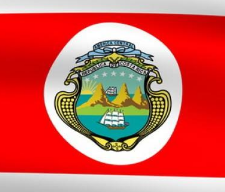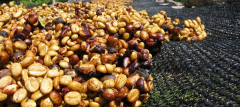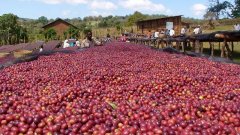Learn more about one of the most well-organized industries in Costa Rica
Costa Rica means "rich coast" in Spanish, so Costa Rica is a magical and rich country. The blue of the sea and the green of the forest together paint this beautiful land-50% of its land is covered by primeval forests, known as "Switzerland in Central and South America".

The shield of Costa Rica's national emblem has the rising sun rising from the sea, symbolizing the dawn of a new era; the three volcanoes Barlois, Ilasu and Boaz are located between the Caribbean and the Pacific Ocean; two white sailboats sail at sea, symbolizing the country's trade with other countries; the seven white five-pointed stars above represent the seven provinces of the country, and the white ribbon above the star says "Republic of Costa Rica". The upper end of the shield emblem is a blue ribbon with the words "Central America" on it. It is flanked by brown long oval leaves, representing coffee and other major cash crops in the country.
The national emblem of Costa Rica contains a lot of information representing the country (of which the three central volcanoes are the most prominent).
Countries prone to earthquakes and volcanoes
The east and west sides of Costa Rica are the Cocos Plate plate (part of the Pacific plate) and the Caribbean plate (Caribbean Plate). The Central American trench (Central America Trench) near the west of Costa Rica is related to the subduction zone of the plate. The Cocos plate moves eastward with 8-9cm every year and continues to submerge under the Caribbean plate. As a result, strong earthquakes and a series of volcanic activity occurred in Costa Rica and its surrounding areas, forming a central volcanic chain. The geotectonic background of the earthquake and volcanic disasters is shown below:
Costa Rica is in the subduction zone of the Cocos plate and the Caribbean plate.
Three-dimensional tectonic dynamic model map of seismic and volcanic formation in the subduction zone of the Cocos plate and the Caribbean plate
Earthquake distribution map of Costa Rica
Due to the development of Costa Rican volcanoes, geothermal resources are very rich. During the field trip after the meeting, we experienced the famous Tabacon Hot Spring near the Arenal Volcano volcano, which is an open hot spring, which is directed from the source to the scenic area through the stream, and forms a variety of hot springs such as waterfalls and streams in the hot spring landscape area. In order to attract Chinese tourists, the Shangri-La Landscape Park with Chinese characteristics has been specially built. When talking to the owner of Tabacon Hot Springs, he said that after the US economic crisis in recent years, the number of tourists from the United States has been decreasing, and he very much hopes that more tourists from Chinese mainland will come here to visit and experience the volcano and hot spring culture.
The source of Tabacon Great Hot Springs near the Arenal volcano in Costa Rica
The shrewd boss set up a Shangri-La landscape park with Chinese characteristics in Tabacon Great Hot Springs.
It is very pleasant to enjoy sunbathing while experiencing hot springs in Tabacon Great Hot Spring Landscape Park.
A country rich in coffee
Costa Rica is divided into two seasons: the rainy season from April to December and the dry season from the end of December to April next year. In the capital San Jose, the average annual temperature is as low as 15 degrees Celsius and up to 26 degrees Celsius. It is said that it is a relatively hot day here, but no matter how big the sun is, there is always a comfortable cool breeze, and there is often a light rain after noon. This unique climate and the fertile volcanic soil of the central basin make Costa Rica rich in coffee.
Coffee was introduced into Costa Rica from Cuba in 1729. Today, its coffee industry is one of the most well-organized industries in the world. Costa Rica, with its fertile volcanic soil and good drainage, is the first country in Central America to grow coffee and bananas for commercial value. Coffee and bananas are the country's main exports, accounting for 25% of Costa Rica's total exports.
High-quality Costa Rican coffee is called "extra hard beans". This kind of coffee can grow above 1500 meters above sea level. Altitude has always been a problem for coffee growers. The higher the altitude, the better the coffee beans, not only because the higher altitude can increase the acidity of the coffee beans and thus increase the flavor, but also because the night temperature at the higher altitude is lower, which can make the trees grow slowly, thus making the coffee beans have a stronger flavor. In addition, due to the high altitude drop caused by sufficient rainfall, is also very beneficial to the growth of coffee trees.
Tarasu, located in the south of the capital San Jose, is one of the most valued coffee growers in the country. LaMinita Tarrazu coffee is a local product, but the production is limited. It is grown on a piece of land called LaMinita, which is owned by the last three generations of the McAlpine family in the UK.
Other coffees worth mentioning are Juan Venus, Tulnon, Vidmir, Montebello and Santa Rosa. Fine coffee usually grows in Eredia and the central canyon. In addition, another kind of coffee is Saatchi (Saatchi is one of the five towns that represent the Coffee Road in Gosgarica), which grows on the slopes of the Poas Volcano volcano, 53km from San Jose. Saatchi, founded in 1949, has a land area of 30770 hectares and grows sugar cane and coffee.
Tarasu in Costa Rica is one of the major coffee producers in the world. The coffee is light and pure in flavor and pleasant in aroma. Its coffee has an excellent flavor, smooth, strong acidity, high grade, and has an attractive flavor.

Important Notice :
前街咖啡 FrontStreet Coffee has moved to new addredd:
FrontStreet Coffee Address: 315,Donghua East Road,GuangZhou
Tel:020 38364473
- Prev

Introduction to the quality of the description method of taste and flavor in Costa Rica Huangmi Coffee Manor
Costa Rican coffee bean flavor Costa Rican yellow honey coffee manor taste description treatment quality introduction, however, in recent years, a new honey treatment method has become fashionable, because there is no need to invest in huge water tanks and drying fields, so that many independent manors or small cooperatives can also afford, some highly skilled and daring manor owners, using this new treatment, a sweetness is improved and low.
- Next

Harald Gimar Kim Bilim of Costa Rica Coffee country Sidamo Yega Chuefei
Ethiopia is called the hometown of coffee, not only because it is the earliest birthplace of coffee in the world, but also because it is a place where coffee is everywhere. There is a custom in this birthplace of coffee that no matter how poor and miserable people are, they must have a coffee pot and a charcoal stove in their home. Because the local people think they have to
Related
- Detailed explanation of Jadeite planting Land in Panamanian Jadeite Manor introduction to the grading system of Jadeite competitive bidding, Red bid, Green bid and Rose Summer
- Story of Coffee planting in Brenka region of Costa Rica Stonehenge Manor anaerobic heavy honey treatment of flavor mouth
- What's on the barrel of Blue Mountain Coffee beans?
- Can American coffee also pull flowers? How to use hot American style to pull out a good-looking pattern?
- Can you make a cold extract with coffee beans? What is the right proportion for cold-extracted coffee formula?
- Indonesian PWN Gold Mandrine Coffee Origin Features Flavor How to Chong? Mandolin coffee is American.
- A brief introduction to the flavor characteristics of Brazilian yellow bourbon coffee beans
- What is the effect of different water quality on the flavor of cold-extracted coffee? What kind of water is best for brewing coffee?
- Why do you think of Rose Summer whenever you mention Panamanian coffee?
- Introduction to the characteristics of authentic blue mountain coffee bean producing areas? What is the CIB Coffee Authority in Jamaica?

